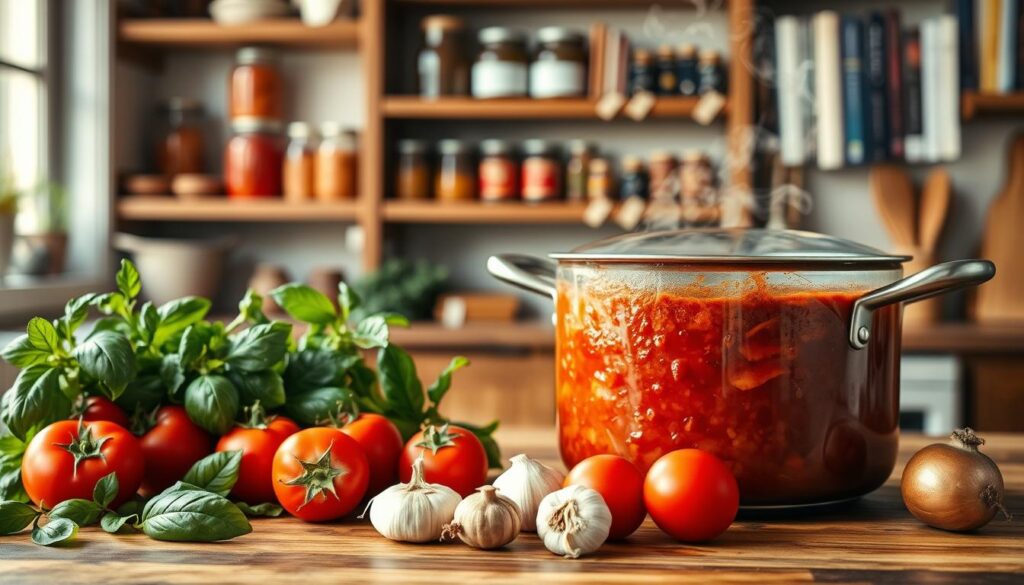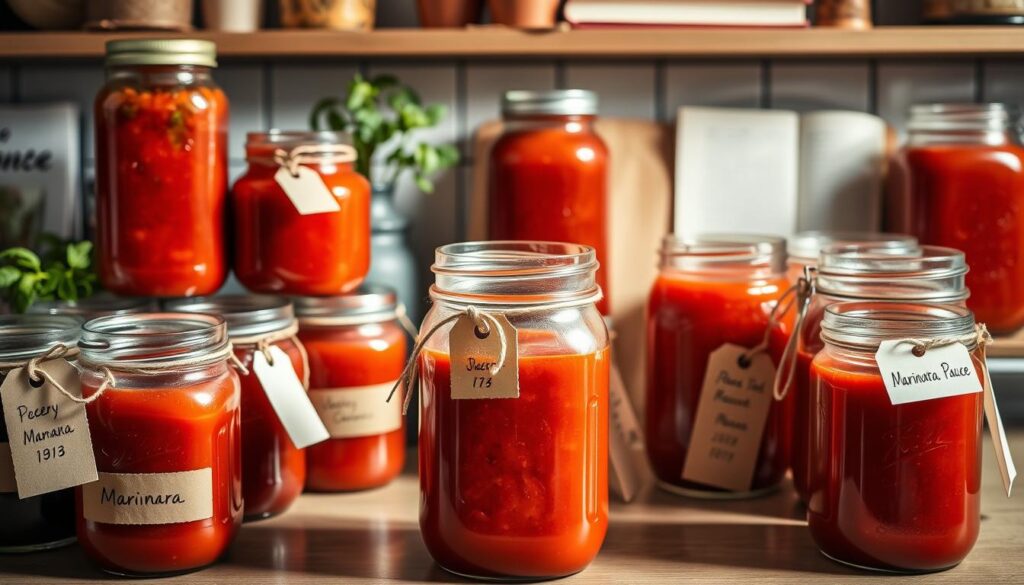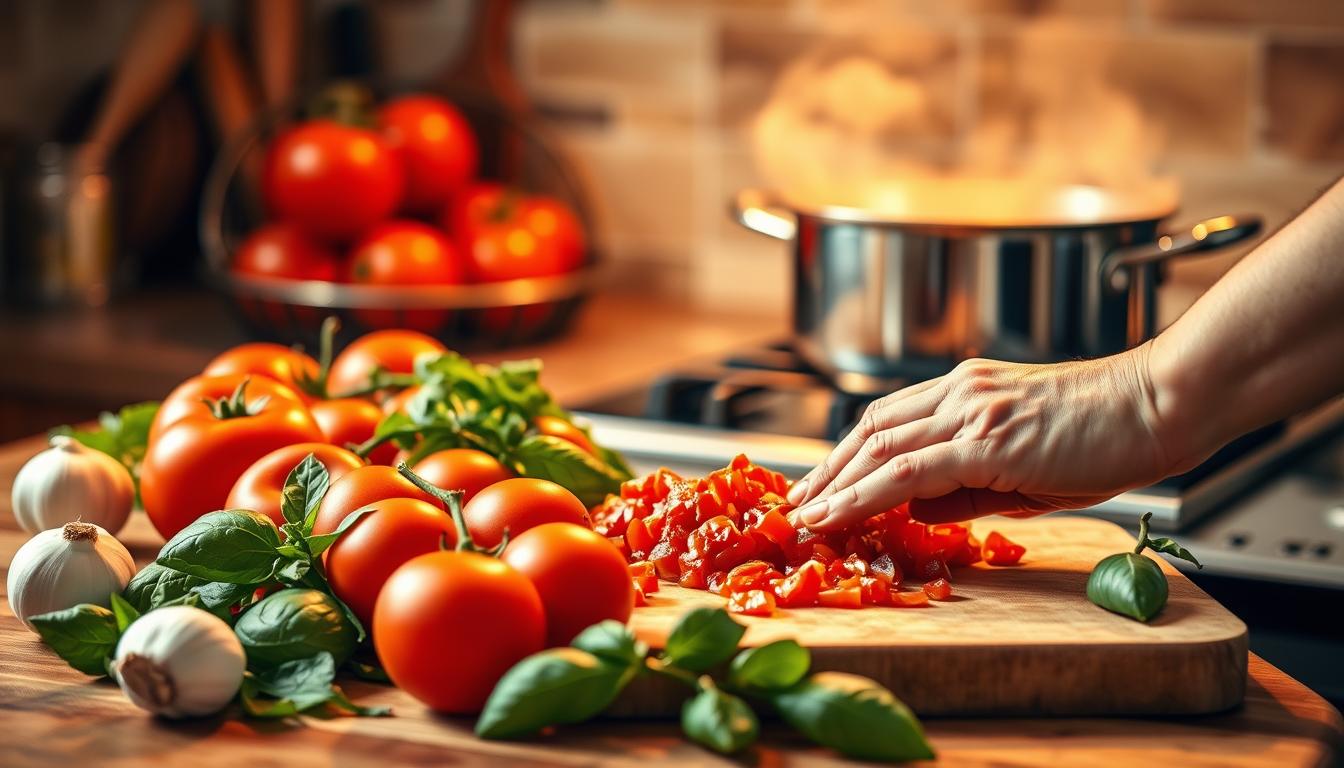Every time I step into my kitchen, the smell of simmering tomatoes takes me back to my grandmother’s kitchen. Making homemade marinara sauce is more than cooking. It’s keeping a tradition alive that connects us through taste and love.
Marinara sauce is not just a sauce. It’s a canvas that makes any meal special. Whether you’re experienced in cooking or new to it, learning to make this sauce will improve your skills. It will also impress everyone you share it with.
In this guide, you’ll learn how to make a marinara sauce that’s better than store-bought. We’ll cover seven easy steps to get rich, vibrant flavors. These steps will help you make a sauce that truly captures the spirit of Italian cooking. Get ready to make your own marinara sauce from scratch.
Get ready for a tasty adventure that will make your kitchen smell like an Italian trattoria. Your homemade marinara sauce is waiting for you!
Understanding Authentic Italian Marinara Basics
Explore the world of authentic marinara sauce, a true Italian treasure. It’s a journey to making the best homemade marinara sauce. You’ll learn about its rich history and special qualities.
Roots of Traditional Marinara
The marinara sauce story starts in 16th-century Naples. Sailors (marinai) created this fast and tasty sauce. Authentic marinara sauce was a quick cooking method for sailors on the sea.
“Marinara is more than a sauce – it’s a culinary tradition passed through generations of Italian families.”
Marinara vs. Regular Tomato Sauce
It’s important to know the difference between marinara and regular tomato sauce. Here are the main differences:
- Cooking Time: Marinara cooks quickly (under 30 minutes)
- Ingredients: Minimal components – tomatoes, garlic, herbs
- Texture: Light, fresh, and vibrant
- Complexity: Simple and direct flavor profile
Characteristics of Perfect Marinara
To make the best homemade marinara sauce, focus on these key points:
- Fresh, high-quality tomatoes
- Balanced acidity
- Bright, clean herb notes
- Smooth, yet slightly chunky texture
Mastering these basics will turn a simple sauce into a true Italian culinary masterpiece.
Essential Ingredients for Marinara Sauce Home Made
Making a real marinara sauce at home needs the right ingredients. The secret to a great homemade tomato sauce is its simplicity and the quality of what you use.
Here’s what makes your marinara sauce stand out:
- Tomatoes: San Marzano tomatoes are the top choice for homemade tomato sauce
- Extra virgin olive oil
- Fresh garlic
- Sweet yellow onions
- Fresh herbs (basil or parsley)
- Sea salt
- Freshly ground black pepper
Now, let’s see how each ingredient helps make a top-notch marinara sauce:
| Ingredient | Flavor Impact | Quality Recommendation |
|---|---|---|
| San Marzano Tomatoes | Rich, sweet base | Whole, canned, imported from Italy |
| Extra Virgin Olive Oil | Smooth, fruity undertone | Cold-pressed, high-quality |
| Fresh Garlic | Aromatic depth | Fresh cloves, not pre-minced |
| Fresh Herbs | Bright, fresh notes | Organic, recently harvested |
Choosing top-notch ingredients turns a basic marinara sauce into a true Italian culinary gem.
Kitchen Tools and Equipment Needed
To make the perfect marinara sauce, you need more than just good ingredients. The right kitchen tools make cooking easier and better. They can also make your sauce taste better.
Choosing the right cooking tools and vessels is key for a great marinara sauce. The tools you pick can change how your sauce tastes and feels.
Recommended Cooking Vessels
For your homemade marinara, pick non-reactive cookware. This type won’t mess with the sauce’s flavor. Here are the top picks:
- Stainless steel saucepans
- Enameled cast iron pots
- Ceramic-coated cookware
Stay away from aluminum or uncoated cast iron pots. They can give your sauce a bad taste.
Essential Utensils for Preparation
| Utensil | Purpose |
|---|---|
| Wooden Spoon | Stirring and preventing sauce from sticking |
| Garlic Press | Crushing garlic for intense flavor |
| Sharp Knife | Chopping herbs and vegetables |
| Cutting Board | Preparing ingredients safely |
Storage Containers
For your marinara sauce, get good storage containers:
- Glass mason jars with tight-fitting lids
- Freezer-safe plastic containers
- Airtight ceramic containers
Pro tip: Pick containers that can go from freezer to fridge. This makes your marinara sauce easy to store and use.
Selecting the Best Tomatoes for Your Sauce
Making the best homemade marinara sauce begins with picking the right tomatoes. The taste and quality of your sauce depend on this key ingredient. Both professional chefs and home cooks agree that choosing the right tomatoes is essential for a true marinara sauce.
San Marzano tomatoes are the top choice for marinara. These Italian plum tomatoes are famous for their:
- Sweet, less acidic flavor profile
- Thick, meaty texture
- Low seed content
- Rich, concentrated tomato taste
Not all tomatoes are created equal when making an authentic marinara sauce. If San Marzano tomatoes are hard to find, you can use these alternatives:
- Roma tomatoes
- Plum tomatoes
- Canned whole peeled tomatoes
“The secret to an incredible marinara sauce is always in the tomatoes.” – Italian Cooking Masterchef
When picking tomatoes for your homemade marinara sauce, keep these points in mind:
| Tomato Type | Flavor Profile | Best Used For |
|---|---|---|
| San Marzano | Sweet, Low Acid | Authentic Marinara |
| Roma | Mild, Balanced | Everyday Sauce |
| Plum Tomatoes | Rich, Dense | Thick Sauces |
Pro tip: Canned tomatoes can be just as good as fresh for marinara sauce. Choose high-quality, whole peeled tomatoes without added preservatives for the best taste.
Proper Preparation Techniques
Making a classic marinara sauce requires mastering key preparation techniques. Success comes from handling ingredients carefully and using precise methods. These steps help bring out the best flavors in your sauce.
Garlic and Onion Preparation Methods
The base of a true marinara sauce is built on how you prepare its ingredients. For your easy marinara sauce recipe, follow these important steps:
- Peel garlic cloves carefully, removing any green sprouts
- Use a sharp knife to finely mince garlic for maximum flavor release
- Dice onions uniformly to ensure even cooking
- Consider using a food processor for consistent chopping
Herb Selection and Processing
Fresh herbs can make your marinara sauce truly special. How you prepare your herbs is very important:
- Choose vibrant, fragrant fresh herbs
- Wash herbs gently to preserve delicate oils
- Pat herbs dry with paper towels
- Chop herbs just before adding to the sauce
Measuring and Portioning Tips
Being precise is key to making a consistent and tasty marinara sauce. Here are some tips for measuring:
- Invest in accurate measuring cups and spoons
- Level dry ingredients for consistent results
- Taste and adjust seasonings incrementally
- Use weight measurements for more accuracy
By mastering these preparation techniques, you’ll take your marinara sauce to the next level. You’ll get a restaurant-quality result every time.
Step-by-Step Cooking Process

Making the perfect marinara sauce at home needs focus on each step. Start by getting your ingredients ready and learning the best ways to get that deep flavor.
- Prepare Your Cooking Station
- Gather all ingredients
- Chop onions and garlic finely
- Measure out herbs and seasonings
- Sauté Aromatics
- Heat olive oil in a heavy-bottomed pot
- Sauté onions until translucent
- Add minced garlic, cook for 30-45 seconds
- Add Tomatoes and Seasonings
- Pour in crushed tomatoes
- Stir in dried herbs
- Season with salt and pepper
- Simmer to Perfection
- Reduce heat to low
- Simmer for 25-30 minutes
- Stir occasionally to prevent sticking
Letting your marinara sauce simmer slowly is key to its rich taste. Keep the heat low to blend the flavors without burning.
| Cooking Stage | Time Required | Key Technique |
|---|---|---|
| Sautéing Aromatics | 3-4 minutes | Medium-low heat |
| Initial Simmering | 15 minutes | Uncovered pot |
| Final Reduction | 10-15 minutes | Low heat, occasional stirring |
Professional chefs say a great marinara sauce comes from patience and skill. By following these steps, you’ll make a sauce as good as any restaurant’s.
Seasoning and Flavor Enhancement Tips
Making a great marinara sauce is more than just the ingredients. It’s about knowing how to mix and boost flavors. With a few expert tips, your homemade sauce can go from good to amazing.
Balancing Acidity Levels
Tomatoes can be quite acidic, which might make your sauce too sharp. Chefs have simple ways to fix this:
- Add a peeled whole carrot during simmering to naturally reduce acidity
- Sprinkle 1/2 teaspoon of sugar to soften sharp tomato notes
- Use sweet onions to counterbalance acidic undertones
Herb Timing and Quantities
Herbs are key to a true marinara sauce. Adding fresh herbs at the right time can change the sauce’s taste a lot.
| Herb Type | Recommended Quantity | Best Timing |
|---|---|---|
| Fresh Basil | 2-3 torn leaves | Last 2-3 minutes of cooking |
| Dried Oregano | 1 teaspoon | Early in cooking process |
| Fresh Parsley | 1 tablespoon chopped | Just before serving |
Your aim is to make a sauce that’s both balanced and full of flavor. It should remind you of traditional Italian cooking. Don’t be afraid to try new things and listen to what your taste buds say.
Storage and Preservation Methods

Keeping your quick marinara sauce fresh is key. After making your homemade marinara, cool it down and store it right. This keeps the taste great and food safe.
Here are the must-do’s for storing your marinara sauce:
- Cool the sauce completely before storing
- Use clean, airtight containers
- Label containers with the preparation date
- Choose the right storage method for how long you’ll use it
Most people store their marinara sauce in the fridge. If stored right, it stays good for 5 days.
| Storage Method | Duration | Best Practices |
|---|---|---|
| Refrigerator | 3-5 days | Use glass or plastic airtight containers |
| Freezer | 2-3 months | Use freezer-safe bags or containers |
Freezing is great for keeping your sauce for longer. Pro tip: Freeze it in small portions for easy meals later. Thaw it in the fridge overnight and reheat it gently to keep the flavor.
Always check for spoilage before eating stored marinara sauce. Look for bad smells or mold.
Serving Suggestions and Pairing Ideas
Your homemade classic marinara sauce is incredibly versatile. It can transform many dishes beyond just pasta. The easy marinara sauce recipe you’ve mastered opens up a world of culinary possibilities. It will delight your family and guests.
The beauty of a classic marinara sauce lies in its adaptability. Whether you’re looking to elevate a simple meal or create a gourmet experience, this sauce can be your secret weapon in the kitchen.
Perfect Pasta Combinations
Selecting the right pasta shape can dramatically enhance your marinara experience. Consider these ideal pairings:
- Spaghetti: Traditional and classic choice
- Penne: Catches sauce in its ridges
- Rigatoni: Wider tubes hold more sauce
- Linguine: Slightly flatter than spaghetti for different texture
Alternative Uses Beyond Pasta
Your easy marinara sauce recipe isn’t limited to pasta dishes. Explore these creative applications:
- Pizza Base: Spread as a delicious foundation
- Dipping Sauce: Perfect for mozzarella sticks or garlic bread
- Baked Dishes: Use in lasagna or eggplant parmesan
- Shakshuka: Simmer eggs directly in the sauce
“A great marinara sauce is like a culinary chameleon – adaptable and always delicious!” – Chef Antonio Rossi
Experiment with your classic marinara sauce and discover new ways to enjoy this versatile culinary staple. The possibilities are truly endless!
Conclusion
Learning to make homemade tomato sauce is a fun journey. It turns simple ingredients into a tasty masterpiece. Your homemade marinara sauce will make any meal special with real Italian taste.
Homemade tomato sauce is easy and flexible. You can try new herbs and adjust the flavors to your liking. Start with a basic recipe and add your own twist to make it your own.
Getting perfect marinara sauce takes time and practice. Don’t worry if it’s not perfect at first. Every try gets you closer to being a pro. Keep track of what you change and learn from each batch.
Your cooking journey is just starting. Try new tomatoes, herbs, and share your sauce with loved ones. The fun of cooking is in the learning and the yummy dishes you make.

